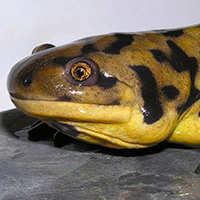Eastern Tiger Salamander
Scientific name: Ambystoma tigrinum

Cover photo credit: Steve Reilly
Status
Extirpated
“Extirpated” means the species lives somewhere in the world, and at one time lived in the wild in Ontario, but no longer lives in the wild in Ontario.
Date added to the Species at Risk in Ontario List
The Eastern Tiger Salamander was already assessed as extirpated when the Endangered Species Act took effect in 2008. It was re assessed as extirpated in 2013.
Read the report (PDF)
What it looks like
The Eastern Tiger Salamander is the largest land-dwelling salamander in North America, averaging 18 to 21 centimetres in length and known to grow to 35 centimetres. It has a thick body with a short snout, sturdy legs, and a long tail. The upper parts are dark brown, dark green or black marked with yellow, gold, or olive blotches, and the belly is olive or yellow with dark mottling.
Where it lives
Eastern Tiger Salamanders require both upland and wetland habitats that contain suitable breeding ponds, forests, and soil types (loamy sand) appropriate for burrowing. Throughout much of the year they live below ground, residing in underground tunnels and burrows or beneath logs.
Adults are usually seen only in spring, when they congregate in lakes and deep ponds to breed. The eggs are laid in clumps attached to submerged vegetation or debris. Newly transformed juveniles leave the lakes in midsummer. When deep ponds do not freeze completely in the winter, there are rare cases wherein some individuals do not transform to the adult form but instead become sexually mature as larvae, or neotenes. Neotenes have external gills and resemble adults. They spend their entire life in the water.
Where it’s been found in Ontario
Whether or not there ever was a population of Eastern Tiger Salamander in Ontario remains unconfirmed. Its historical existence here is based solely on a single accepted specimen, reported to have been collected in 1915 at Point Pelee.
The Eastern Tiger Salamander range extends from Long Island, New York southward along the Atlantic coastal plain; westward along the Gulf of Mexico to southeastern Louisiana; and then northward from Alabama through much of lower Michigan. It ranges unevenly through many of the states north and east of that core, but is absent from most of the Appalachian uplands and the lower Mississippi River delta region. Small, isolated populations have been found elsewhere, including the Ohio islands in western Lake Erie.
View a Larger version of this map (PDF)
Why it disappeared from Ontario
Due to the uncertainty of its historical existence as a viable population in Ontario, the exact causes of its decline here cannot be determined. However, throughout its range, the main threats to this species are water pollution, fish stocking of lakes, and disease. Pesticide run-off into lakes and ponds is known to affect salamander development and survival. Salamanders are vulnerable to fish predation during the larval stages and are generally found in fish-free lakes. Viral diseases are known to have caused die-offs in Eastern Tiger Salamander populations in Manitoba, Saskatchewan and some U.S. regions. Disease epidemics are particularly threatening to small, isolated populations.
Action we are taking
Extirpated species and their habitat are protected if the species are again found in Ontario.
Help make sure we don’t lose more endangered species in Ontario
- Watch for reptiles and amphibians that may be crossing roads between May and October. Road mortality is a serious threat to many of these species. If it is safe to do so, help reptiles and amphibians across the road in the direction they were headed.
- Volunteer with a local nature club or provincial park to participate in surveys or stewardship work focused on species at risk.
- Report any illegal activity related to plants and wildlife to
1-866-MOE-TIPS (663-8477) . - Private land owners have an important role to play in species recovery. You may be eligible for stewardship programs that support the protection and recovery of species at risk and their habitats.
- Volunteer with a local nature club or provincial park to participate in surveys or stewardship work focused on species at risk.
- Visit the Ontario Reptile and Amphibian Atlas or Toronto Zoo Adopt-a-Pond website to learn more about Ontario’s rare snakes, their habitat and related conservation initiatives.
Quick facts
- Eastern Tiger Salamanders belong to a group of burrowing amphibians known as mole salamanders. Their broad heads have blunt, rounded snouts that enable them to burrow underground.
- Eastern Tiger Salamanders are highly voracious predators, emerging from their burrows at night to feed on worms, insects, frogs, and even other salamanders.
- Eastern Tiger Salamanders are long-lived, averaging 10 to 16 years in the wild.
- Although populations of many plants and animals have been declining worldwide, amphibians are experiencing an especially dramatic decline. The loss of these sensitive creatures may act as a warning that our own environment is being dangerously altered and polluted.
